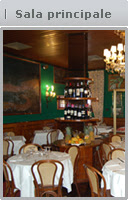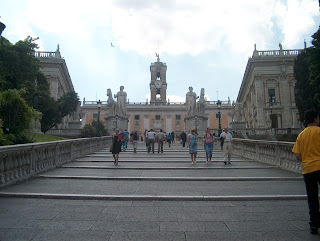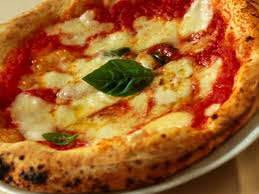For those who would like a special dinner in Rome on Saturday night, I've put together a list of possible restaurants for you to look through. Fair warning, most of these are on the expensive side, but all are well known and respected; several have Michelin stars. Click on the name of each restaurant to go to their web site. Reservations will be required at each of these places and should be made at least a week in advance (before we leave for Italy).
La Pergola
Situated a little outside of the historic center, La Pergola's top floor location at the Cavalieri Hilton hotel commands a phenomenal view of Vatican City. It's also the only three-star Michelin restaurant in Rome. (Click on the restaurant name to view their web site.)
Il Pagliaccio
Il Pagliacio is not far from Campo dei Fiori or Piazza Navona, on a block that parallels Via Giulia, a famous street of palazzi and antique shops. (Click on the restaurant name to view their web site.)
Checchino dal 1887
As the name indicates, Checchino dal 1887 has been a favorite in Rome for more than a century. Located in the Testaccio section, it is a little over three miles from our hotel.
Agata e Romeo
Less than a mile from our hotel (about ten blocks on foot) and quite close to the beautiful Santa Maria Maggiore, Agata e Romeo's decor matches its high end cuisine.
Ristorante Piperno
Perhaps the most well known restaurant in the Jewish Ghetto, Piperno is about a mile and a third from our hotel.
Il Convivio
Also about a mile and a third from our hotel, Il Convivio offers high end cuisine in a more intimate atmosphere.
Mirabelle
Talk about a room with a view! Located just south of Villa Borghese, Mirabelle overlooks Rome from the opposite direction of the first restaurant on our list (La Pergola, at the Hilton). Mirabelle is just seven tenths of a mile from our hotel.
This is the blog for family, friends and the travelers who will journey together to Sorrento and Rome in October, 2011.
Sunday, August 28, 2011
Thursday, August 25, 2011
Naples - Certosa di San Martino
 |
| The view of San Martino |
 |
| The view from San Martino |
Equally impressive is the sacristy:
After all that decoration, the quiet and peaceful great cloister is a welcome break.
The former friars quarters now house the museum and its collection of paintings and prints illustrating the Certosa and the history of Naples. The collection also includes porcelin, furniture, objects d'art, carriages and a large collection of presepi (nativity scenes).
 |
| Presepe Cuciniello |
San Martino is closed on Wednesdays, the day we will be in Naples as a group, but it is open on Thursday, our free day. I'd encourage anyone who is planning to spend part of their free time in Naples to check out the Certosa di San Martino.
The easiest way to get up there is by cab but for the more adventurous, you can take the metro from the train station to the Montesanto stop, then the Montesanto funicular up the mountain. From the funicular station it's a short walk (0.3 mile) to the museum.
The web site for the Certosa is only in Italian, unfortunately, but if you can read a little in la bella lingua, check it out here.
Wednesday, August 24, 2011
Rome - Baroque Masters
The Baroque period continued the evolution of Rome's art and architecture and produced three masters of its own, Bernini (sculptor and architect), Borromini (architect), and Carravaggio (painter).
Maybe I'm biased, but I think that Bernini (1598 - 1680) defined Rome and put his stamp on the city even more than Michelangelo did a century earlier. Beginning with sculpture while still a teenager, Bernini progressed to architecture but continued to sculpt throughout most of his long life.
The Museo e Galleria Borghese in Rome is home to three of Bernini's most impressive sculptures, Aeneas, Anchises, and Ascanius Fleeing Troy, Pluto and Proserpina, and David. It's hard to believe, when looking at his work, that this is actually marble. You can see what I mean in the detail of Pluto's hand grasping Proserpina's thigh:
Two other important sculptures are housed in churches in Rome, Ecstasy of St. Teresa at Santa Maria della Vittoria (made even more famous by Dan Brown's Angels & Demons) and Ecstasy of Beata Ludovica Albertoni at San Francesco a Ripa.
Bernini is also well represented by water, most notably by the Fontana dei Quattro Fiumi (Fountain of the Four Rivers) in Piazza Navona.
Bernini the architect can be seen in two vastly different structures, the small, elegant and personal feeling Sant'Andrea al Quirinale (just six blocks from our hotel in Rome) and the vast, grandiose Colonnade of St. Peter's Square. The colonnade solved a number of architectural issues and tied together the hodgepodge of buildings that made up the Vatican Palace. When viewed from the dome of St. Peter's, you can see the colonnade as a pair of welcoming arms, hugging pilgrims as they approach the basilica.
The work and style of Borromini, Bernini's contemporary and rival, is perhaps best represented by the tiny church of San Carlo alle Quattro Fontane (also known as San Carlino). Located just one block away from Bernini's Sant'Andrea al Quirinale (and only five blocks from our hotel), San Carlino is a complex marvel of light, intricate details and multiple dimensions.
Sant'Ivo della Sapienza, another Borromini creation, may be the most dramatic church in Rome. The spiral lantern on top is immediately identifiable, there's just nothing else like it.
Caravaggio was profoundly gifted and deeply disturbed, in nearly equal measure. Before beating it out of town just ahead of a murder charge, he pioneered a new way of using light and shadow in painting and was the first to paint biblical subjects in a naturalistic manner. The best of example of this is the St. Matthew trilogy at San Luigi dei Francesi. The Crucifixion of St. Peter in the Cerasi Chapel at Santa Maria del Popolo is another case in point.
Maybe the most amazing thing about all of this tremendous art is that most of it can be viewed at no charge. There is a fee to enter the Borghese, but all of the churches, fountains and squares are free.
Maybe I'm biased, but I think that Bernini (1598 - 1680) defined Rome and put his stamp on the city even more than Michelangelo did a century earlier. Beginning with sculpture while still a teenager, Bernini progressed to architecture but continued to sculpt throughout most of his long life.
 |
| Bernini's David |
 |
| Detail from Pluto and Proserpina |
 |
| Ecstasy of Beata Ludovica Albertoni |
 |
| Detail from Bernini's Fontana dei Quatro Fiumi, Piazza Navona |
 |
| Sant'Andrea al Quirinale |
 |
| Bernini's Colonnade, Piazza San Pietro |
Sant'Ivo della Sapienza, another Borromini creation, may be the most dramatic church in Rome. The spiral lantern on top is immediately identifiable, there's just nothing else like it.
Caravaggio was profoundly gifted and deeply disturbed, in nearly equal measure. Before beating it out of town just ahead of a murder charge, he pioneered a new way of using light and shadow in painting and was the first to paint biblical subjects in a naturalistic manner. The best of example of this is the St. Matthew trilogy at San Luigi dei Francesi. The Crucifixion of St. Peter in the Cerasi Chapel at Santa Maria del Popolo is another case in point.
 |
| Caravaggio The Calling of St. Matthew |
Monday, August 22, 2011
Rome - Renaissance Masters
The Renaissance was underway in Florence and Venice for a century before Rome caught up. They made up for that slow start, however, with a massive rebuilding effort that transformed the look of the city.
The three most influential masters of the Renaissance in Rome were Raphael (painter), Bramante (architect), and the great triple threat, Michelangelo (painter, sculptor, architect).
You can see Michelangelo's architectural work at the Campidoglio, where he redesigned the piazza (including the unique geometric paving) and added new facades to the buildings facing it (today these buildings are the Capitoline Museums and the office of the Mayor of Rome). He also designed the great staircase that leads up to the piazza, the Cordonata.
Not far from the Campidoglio you can see one of Michelangelo's most famous sculptures, Moses, at San Pietro in Vincoli. This church is named after its most famous relics, the chains (vincoli) that are believed to have shacked St. Peter while he was held in the Mamertine prison.
Of course, his most famous sculpture is the Pieta, located inside St. Peter's Basilica.
The Sistine Chapel holds Michelangelo's two most famous paintings (actually one fresco and one painting), the Creation of the World and the Fall of Man on the ceiling, and The Last Judgment over the altar.
Although many (if not most) of the great architects of the Roman Renaissance and Baroque periods had a hand in St. Peter's Basilica (including Michelangelo, who was responsible for the magnificent dome), the first and principle architect was Donato Bramante. Although he also had a hand in the design of Santa Maria della Pace, Bramante is probably best known for, and represented by, the Tempietto (little temple) at San Pietro in Montorio. This small circular building is generally considered to be the first true Renaissance building in Rome.
Better known for his frescos, Raphael also worked as an architect in Rome, notably on the Chigi Chapel at Santa Maria del Popolo. His frescos for the private apartments of Pope Julius II are together known as the Raphael Rooms. The work on these four rooms took over 16 years and Raphael died before it was completed, but they remain perhaps the best expression of the religious and philosophical ideals of the Renaissance.
The three most influential masters of the Renaissance in Rome were Raphael (painter), Bramante (architect), and the great triple threat, Michelangelo (painter, sculptor, architect).
 |
| Piazza del Campidoglio |
Not far from the Campidoglio you can see one of Michelangelo's most famous sculptures, Moses, at San Pietro in Vincoli. This church is named after its most famous relics, the chains (vincoli) that are believed to have shacked St. Peter while he was held in the Mamertine prison.
 |
| Michelangelo's Moses |
 |
| Michelangelo's Pieta |
 |
| The Last Judgment |
 |
| Bramante's Tempietto |
 |
| Raphael The Fire in the Borgo |
Saturday, August 20, 2011
Sant'Agata sui Due Golfi
Just five miles by car from our hotel in Sorrento, or three miles by foot (for the truly ambitious and those in good shape, because much of this walk is uphill) is the lovely little town of Sant'Agata sui Due Golfi. With spectacular views of the gulfs of Naples and Salerno (the "due golfi"), Sant'Agata was a favorite stop on the "Grand Tour" and, even further back, was enjoyed by the Etruscans, Greeks and Romans.
There is a lovely town center and the beautiful church with its Florentine inlaid marble altar, which was moved here from the Girolamini church in Naples in 1845.
Sant'Agata's most famous restaurant is Don Alfonso 1890. Known for its cuisine, dishes at Don Alfonso use local ingredients and herbs, many grown on their own farm nearby, and are based on three principles: Mediterranean character, absolute quality in raw materials, and modernity. You can read more about their history, philosophy and the restaurant itself on their web site here. They've also produced a beautiful brochure that can be downloaded here.
More information about the town of Sant'Agata sui Due Golfi can be found here.
There is a lovely town center and the beautiful church with its Florentine inlaid marble altar, which was moved here from the Girolamini church in Naples in 1845.
Sant'Agata's most famous restaurant is Don Alfonso 1890. Known for its cuisine, dishes at Don Alfonso use local ingredients and herbs, many grown on their own farm nearby, and are based on three principles: Mediterranean character, absolute quality in raw materials, and modernity. You can read more about their history, philosophy and the restaurant itself on their web site here. They've also produced a beautiful brochure that can be downloaded here.
 |
| Don Alfonso 1890 Restaurant |
Friday, August 19, 2011
Pizza
With all the wonderful things to see and do in Naples, the question I am most often asked is "where do I get real Naples pizza?"
They take their pizza seriously in Naples, which is the home of the Pizza Napoletana Association, a non-profit group dedicated to promoting and producing the "true Neapolitan pizza". Members of the association commit to making pizza using the traditional methods and ingredients. Associazione Verace Pizza Napoletana
So where to go in Naples? It depends on what part of town you find yourself in, but here are some of the best:
Da Michele (Via Sersale, 13): A few blocks from the train station, this is perhaps the most famous pizzaria in Naples. It doesn't look like much from the outside (nor from the inside, to be honest), but the lines of people waiting for them to open each day testify to their greatness.
Di Matteo (Via dei Tribunali, 94): In the heart of the centro storico of Naples, Da Matteo has been serving pizza in Naples since 1936. Again note the crowds outside.
Lombardi (Via Foria, 12): Near the Archeology Museum, Lombardi is known for creative combinations and larger sized pizzas.
A true Italian pizza is always served in a "personal" size, meant for one person, unlike the large multi-slice pies we are accustomed to here at home. They are approximately the size of a large dinner plate.
The other way to get pizza is "pizza al taglio" (cut pizza, sometimes referred to as "pizza rustica"), which is sold a slice at a time by weight and meant to be eaten standing up. It is generally made in large, flat pans which are displayed in a case. Once you choose your type and specify the weight you want, it is reheated and then served.
They take their pizza seriously in Naples, which is the home of the Pizza Napoletana Association, a non-profit group dedicated to promoting and producing the "true Neapolitan pizza". Members of the association commit to making pizza using the traditional methods and ingredients. Associazione Verace Pizza Napoletana
So where to go in Naples? It depends on what part of town you find yourself in, but here are some of the best:
 |
| Da Michele |
 |
| Di Matteo |
Lombardi (Via Foria, 12): Near the Archeology Museum, Lombardi is known for creative combinations and larger sized pizzas.
A true Italian pizza is always served in a "personal" size, meant for one person, unlike the large multi-slice pies we are accustomed to here at home. They are approximately the size of a large dinner plate.
The other way to get pizza is "pizza al taglio" (cut pizza, sometimes referred to as "pizza rustica"), which is sold a slice at a time by weight and meant to be eaten standing up. It is generally made in large, flat pans which are displayed in a case. Once you choose your type and specify the weight you want, it is reheated and then served.
Wednesday, August 17, 2011
Amalfi Coast - Getting in the Mood
Capri - Getting in the Mood
Subscribe to:
Comments (Atom)
























